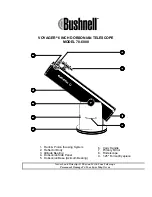
TELESCOPE USE
SELECTING AN EYEPIECE:
1.
You should always start viewing with the lowest power eyepiece, which in this case is the 25
mm lens. Note: the base power of each eyepiece is determined by the focal length of the
telescope objective element, which for this model is 1000 mm. A formula can be used to
determine the power of each eyepiece:
telescope OBJECTIVE mirror focal length
EYEPIECE focal length = MAGNIFICATION
(e.g. Using the 25 mm lens, the calculation
would look like this: 1200 mm
÷
25mm = 48x or 48 power.)
2.
Offered as an accessory for this telescope is a Barlow lens (model #78-0105). Barlow lenses
are used to double or triple the power of your telescope by placing your Barlow between the
focusing tube and the eyepiece. Using the example above, a 2x Barlow lens would give you a
total power of 96x or 96 power. (48 x 2 = 96x or 96 power). Other accessories available
include a 9mm eyepiece (model #78-0101) that would give you 133x or 133 power or 266x
when used in conjunction with the Barlow accessory and a standard camera adapter (model
#78-0104) for photographing the night sky.
FOCUSING TELESCOPE:
1.
After inserting the eyepiece, aim the main telescope tube at a land-based target at least 200
yards away (e.g. A telephone pole or building). Fully extend focusing tube by turning Rack &
Pinion Focusing Mechanism
(1)
2.
While looking through selected eyepiece (in this case the 25 mm), slowly retract focusing
tube by turning Rack & Pinion Focusing Mechanism
(1) until object comes into focus.
ALIGNING FINDERSCOPE:
1.
Look through low-power 1.25" format eyepiece (9) and establish a well-defined target (see
focusing telescope section).
2.
Looking through Finderscope (8), alternate tightening each
Finderscope Adjustment Screw
surrounding the Finderscope (8) in the Finderscope Mount until crosshairs of Finderscope (8)
are precisely centered on the same object already centered in Main Telescope Tube's field of
view as seen through the 1.25" Format Eyepiece (9).
3.
Now, objects located first with the Finderscope (8) will be centered in the field of view of the
main telescope as seen through the 1.25" Format Eyepiece (9).
COLLIMATING THE TELESCOPE
Good alignment or collimation of the telescope's optical components will guarantee the most
optimum viewing.
This telescope body comes preassembled from the factory and
precollimated. Therefore collimation should not be required.
However, due to its great
importance there are a few steps that you can take to ensure that your telescope is properly
collimated.
1.
Remove the 1.25" Format Eyepiece (9) from the Rack and Pinion Focusing Mechanism (1).
2.
Look into the Rack and Pinion Focusing Mechanism (1) with the eyepiece removed. You will
see the secondary mirror located a few inches inside the end of the telescope tube (nearest the
Rack and Pinion Focusing Mechanism). Since it is a mirror, you will see a reflection of the
large primary mirror (7). That mirror will show an image of the secondary mirror and your
eye. Each image will be centered in a concentric set of images starting with the image of the
Primary Mirror (7), the secondary mirror, and your eye.
3.
Please refer to the diagram to see what to expect.









